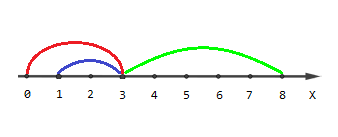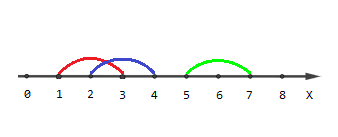3 seconds
256 megabytes
standard input
standard output
You are given
n
n segments on a coordinate line; each endpoint of every segment has integer coordinates. Some segments can degenerate to points. Segments can intersect with each other, be nested in each other or even coincide.
Your task is the following: for every
k
∈
[
1..
n
]
k∈[1..n], calculate the number of points with integer coordinates such that the number of segments that cover these points equals
k
k. A segment with endpoints
l
i
li and
r
i
ri covers point
x
x if and only if
l
i
≤
x
≤
r
i
li≤x≤ri.
The first line of the input contains one integer
n
n (
1
≤
n
≤
2
⋅
10
5
1≤n≤2⋅105) — the number of segments.
The next
n
n lines contain segments. The
i
i-th line contains a pair of integers
l
i
,
r
i
li,ri (
0
≤
l
i
≤
r
i
≤
10
18
0≤li≤ri≤1018) — the endpoints of the
i
i-th segment.
Print
n
n space separated integers
c
n
t
1
,
c
n
t
2
,
…
,
c
n
t
n
cnt1,cnt2,…,cntn, where
c
n
t
i
cnti is equal to the number of points such that the number of segments that cover these points equals to
i
i.
3
0 3
1 3
3 8
6 2 1
3
1 3
2 4
5 7
5 2 0
The picture describing the first example:

Points with coordinates
[
0
,
4
,
5
,
6
,
7
,
8
]
[0,4,5,6,7,8] are covered by one segment, points
[
1
,
2
]
[1,2] are covered by two segments and point
[
3
]
[3] is covered by three segments.
The picture describing the second example:

Points
[
1
,
4
,
5
,
6
,
7
]
[1,4,5,6,7] are covered by one segment, points
[
2
,
3
]
[2,3] are covered by two segments and there are no points covered by three segments.
这题坑点比较多,没有开LLwa一发 ,数组开小了又wa一发 难受
细节方面很多都没有注意到
这题是纯思维题 把每一个区间分为两个点一个左端点一个右端点
进行排序一下,就出来了
从左往右扫一遍经历一次左端点就加一,经历一次又端点就减一
这个规律看图一下就出来了


1 #include <bits/stdc++.h> 2 using namespace std; 3 const int maxn = 4e5 + 10; 4 typedef long long LL; 5 struct node { 6 LL x, y; 7 node (LL x, LL y) : x(x), y(y) {} 8 node () {} 9 } qu[maxn]; 10 int cmp(node a, node b) { 11 if (a.x == b.x) return a.y > b.y; 12 return a.x < b.x; 13 } 14 LL ans[maxn]; 15 int main() { 16 LL n,k=0,a,b; 17 scanf("%lld", &n); 18 for (int i = 0 ; i < n ; i++) { 19 scanf("%lld%lld",&a,&b); 20 qu[k++] = node(a, 1); 21 qu[k++] = node(b + 1, -1); 22 } 23 sort(qu, qu + k, cmp); 24 LL temp = 0; 25 for(int i = 0 ; i < k-1 ; i++ ) { 26 temp += qu[i].y; 27 if (qu[i].x != qu[i + 1].x) ans[temp]+= qu[i + 1].x - qu[i].x; 28 } 29 for (int i = 1 ; i <=n ; i++) 30 printf("%lld ", ans[i]); 31 printf("\n"); 32 return 0; 33 }
View Code
转载于:https://www.cnblogs.com/qldabiaoge/p/9267936.html